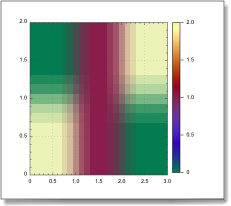SmileLab defines a data type which derives from array of real: matrix.
-
A matrix is a structure (an AppleScript record) which contains, in addition to the data stored as an array of real, two positive integers which define a number of rows (nrows) and a number of columns (ncols). Thus, the array of real should contain exactly nrows * ncols values. matrices store 2-d parametric sets of scalars. For instance you would describe a 2-d parametric surface in a 3-d space with three matrices representing (x(u, v), y(u, v), z(u, v)).
set x to {0, 1, 2, 2, 1, 0}
set m to {class:matrix, ncols:3, nrows:2, array of real:x}
When this makes sense, SmileLab will consider m as a 2-d array such as (for the example above):
0 1 2
2 1 0
-
The array of real field of the matrix stores the 2-d array first row first.
-
To make the values contained in an matrix into a tabulated text, use the display command.
set x to {0, 1, 2, 2, 1, 0}
set m to {class:matrix, ncols:3, nrows:2, array of real:x}
quietmsg(display m)
-- Result:
0.0 1.0 2.0
2.0 1.0 0.0
-
To visualize a matrix in few seconds use QuickBitMap or QuickScalarMap.
set x to {0, 1, 2, 2, 1, 0}
set m to {class:matrix, ncols:3, nrows:2, array of real:x}
QuickBitMap(m, 0)
|

|


